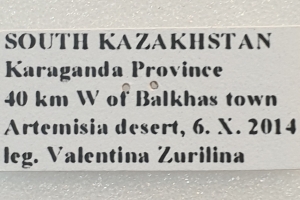Version 22 / 24 vom 1. Oktober 2022 um 18:25:04 von Jürgen Rodeland
Länder:

 +9Kontinente:EUAS
+9Kontinente:EUAS


 +9Kontinente:EUAS
+9Kontinente:EUASInhalt
2. Diagnose
2.1. Männchen
1-2: ♂, Holotypus ssp. centralasiae Hacker & Behounek, 1990: Tadschikistan, Chorog, Daten siehe Etiketten (fot: Michel Kettner), coll. ZSM
3-4: ♂, Kasachstan, Daten siehe Etikett (fot.: Jan Buchner), det. B. Benedek
3. Weitere Informationen
3.1. Andere Kombinationen
- Brachionycha atossa Wiltshire, 1941 [Originalkombination]
3.2. Unterarten
- Polymixis atossa limula (Sukhareva, 1978)
- Polymixis atossa derrai (Hacker, 1990)
- Polymixis atossa centralasiae Hacker & Behounek, 1990
3.3. Faunistik
Bisher ist aus Europa nur ein einziges Exemplar aus dem Jahr 2005 aus dem Südural bekannt (Fibiger & Hacker 2007).
3.4. Typenmaterial
Die Art wurde nach einem einzigen ♀ beschrieben, Wiltshire (1941: 475): “Holo-type, ♀, Khan-i-Zinian, Fars, 8-xi-40 (c. 6000 ft.) in coll. mea.” Auf der Tafel, fig. 9, ist der Holotypus abgebildet.
3.5. Literatur
- Fibiger, M. & H. Hacker (2007): Noctuidae Europaeae. Volume 9. Amphipyrinae, Condicinae, Eriopinae, Xyleninae (part). — 410 S., 12 Farbtafeln; Sorø (Entomological Press).
- Erstbeschreibung der Unterarten P. a. derrai und centralasiae: Hacker, H. (1990): Die Noctuidae Vorderasiens (Lepidoptera) Systematische Liste mit einer Übersicht über die Verbreitung unter besonderer Berücksichtigung der Fauna der Türkei (einschließlich der Nachbargebiete Balkan, Südrußland, Westturkestan, Arabische Halbinsel, Ägypten). — Neue Entomologische Nachrichten 27: 1-707, pl. 1-16 [hier: 451-454]. [PDF auf zobodat.at (ca. 65 MB)].
- Erstbeschreibung: Wiltshire, E. P. (1941): New Lepidoptera from S. W. Iran. — The Journal of the Bombay Natural History Society 42: 472-477, 1 pl. Ex libris Werner Wolf. — Digitalisat auf archive.org: [475], [pl.].














